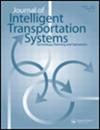Deep learning-based pedestrian trajectory prediction and risk assessment at signalized intersections using trajectory data captured through roadside LiDAR
IF 2.8
3区 工程技术
Q3 TRANSPORTATION
Journal of Intelligent Transportation Systems
Pub Date : 2024-11-01
DOI:10.1080/15472450.2023.2209912
引用次数: 0
Abstract
In recent years, rapid advancements in the Autonomous Vehicles (AVs) industry have greatly motivated the research and development in pedestrian trajectory prediction and risk assessment. One of the critical requirements for AVs is to predict the future trajectories of pedestrians and provide collision warnings in an accurate and prompt manner. Nevertheless, accurate prediction of pedestrian trajectories remains a technical challenge, mainly caused by the heterogeneity of pedestrian crossing behavior and uncertainties in vehicle-pedestrian interactions. This paper proposes a deep learning-based method for pedestrian trajectory prediction and risk assessment, using trajectory data extracted from roadside LiDAR data and corresponding signal phasing information at MLK and Georgia Avenue in Chattanooga, TN. Meanwhile, a set of criteria referred to as the risk factor is established to quantitatively evaluate the risk of the pedestrian crossing behavior, which also serves as a learnable feature. A Long Short-Term Memory (LSTM) network is proposed, which takes the following data as the input: the pedestrian trajectory data, signal phasing data, and risk factors from the past 10 steps. Meanwhile, the network predicts the pedestrian trajectory and risk factor at the future time step. In the experimental study, the root-mean-square errors between the predicted and ground truth x and y coordinates are 0.225 meters and 0.377 meters, respectively, and the F1 score value for the risk factor is 99.6%, demonstrating the efficacy of the proposed LSTM-based methodology on pedestrian trajectory prediction and risk assessment.
基于深度学习的行人轨迹预测和风险评估,使用路边激光雷达捕获的轨迹数据
近年来,自动驾驶汽车行业的快速发展极大地推动了行人轨迹预测和风险评估的研究与发展。自动驾驶汽车的关键要求之一是预测行人的未来轨迹,并以准确和及时的方式提供碰撞警告。然而,行人轨迹的准确预测仍然是一个技术挑战,主要是由于行人过马路行为的异质性和车-人相互作用的不确定性。本文提出了一种基于深度学习的行人轨迹预测和风险评估方法,该方法利用美国田纳西州查塔努加(Chattanooga)的MLK和Georgia Avenue的路边LiDAR数据提取的轨迹数据和相应的信号相位信息,同时建立了一套称为风险因子的标准,定量评估行人过马路行为的风险,这也是一种可学习的特征。提出了一种长短期记忆(LSTM)网络,该网络以以下数据作为输入:行人轨迹数据、信号相位数据和过去10步的风险因素。同时,该网络预测未来时间步长的行人轨迹和危险因素。在实验研究中,预测值与真实值x、y坐标的均方根误差分别为0.225米和0.377米,风险因子F1得分值为99.6%,证明了基于lstm的行人轨迹预测和风险评估方法的有效性。
本文章由计算机程序翻译,如有差异,请以英文原文为准。
求助全文
约1分钟内获得全文
求助全文
来源期刊
CiteScore
8.80
自引率
19.40%
发文量
51
审稿时长
15 months
期刊介绍:
The Journal of Intelligent Transportation Systems is devoted to scholarly research on the development, planning, management, operation and evaluation of intelligent transportation systems. Intelligent transportation systems are innovative solutions that address contemporary transportation problems. They are characterized by information, dynamic feedback and automation that allow people and goods to move efficiently. They encompass the full scope of information technologies used in transportation, including control, computation and communication, as well as the algorithms, databases, models and human interfaces. The emergence of these technologies as a new pathway for transportation is relatively new.
The Journal of Intelligent Transportation Systems is especially interested in research that leads to improved planning and operation of the transportation system through the application of new technologies. The journal is particularly interested in research that adds to the scientific understanding of the impacts that intelligent transportation systems can have on accessibility, congestion, pollution, safety, security, noise, and energy and resource consumption.
The journal is inter-disciplinary, and accepts work from fields of engineering, economics, planning, policy, business and management, as well as any other disciplines that contribute to the scientific understanding of intelligent transportation systems. The journal is also multi-modal, and accepts work on intelligent transportation for all forms of ground, air and water transportation. Example topics include the role of information systems in transportation, traffic flow and control, vehicle control, routing and scheduling, traveler response to dynamic information, planning for ITS innovations, evaluations of ITS field operational tests, ITS deployment experiences, automated highway systems, vehicle control systems, diffusion of ITS, and tools/software for analysis of ITS.

 求助内容:
求助内容: 应助结果提醒方式:
应助结果提醒方式:


